Summary Overview
Jerry Cans Market Overview
The global jerry can market is steadily growing, driven by rising demand in industries such as manufacturing, retail, healthcare, and logistics. This market covers a wide variety of jerry can designs, from ordinary plastic and metal to specialist variants for hazardous compounds and food-grade applications. Our paper provides a thorough examination of procurement trends, with an emphasis on cost-cutting techniques and the use of modern solutions to expedite purchase and operational procedures.
Looking ahead, important challenges in the jerry can market include managing rising manufacturing costs, assuring product longevity, maintaining safety regulations, and incorporating new materials and technologies. Digital procurement technologies and strategic sourcing will be critical for streamlining supply chain procedures, improving logistics, and ensuring long-term market competitiveness. As global demand rises, businesses are increasingly looking to market information to improve operational efficiency, reduce risks, and stay competitive in an ever-changing industry.
Market Size The global Jerry Cans market is projected to reach USD 5.19 billion by 2035, growing at a CAGR of approximately 4.71% from 2025 to 2035.
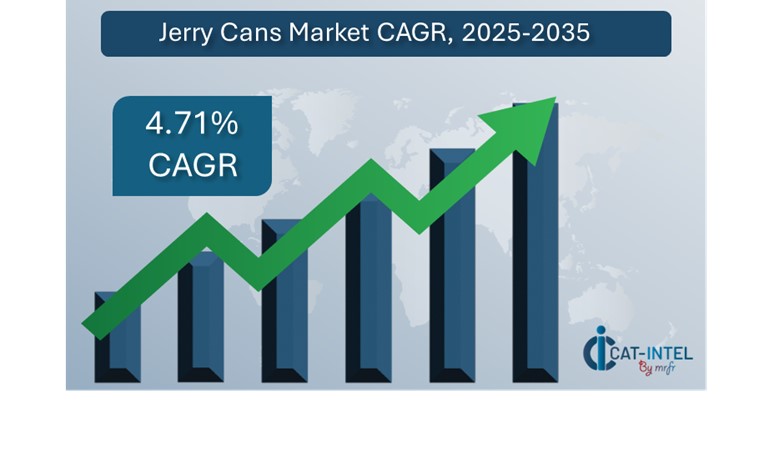
Growth Rate 4.71%
-
Sector Contributions Growth in the market is driven by -
Manufacturing and Supply Chain Optimization The demand for real-time data and seamless process integration is increasing, with the goal of streamlining operations and improving supply chain efficiency across several industries.
-
Retail and E-Commerce Growth To accommodate rising demand in both physical and online stores, Jerry can manufacturers are implementing cutting-edge solutions to improve inventory management and ensure timely delivery.
-
Technological Transformation Innovations in AI and machine learning are playing a critical role in streamlining production processes for jerry cans, allowing predictive analytics and automation to improve efficiency.
-
Innovations Modular solutions are gaining popularity in the jerry can sector, allowing producers to select only the elements they need.
-
Investment Initiatives Businesses are rapidly investing in cloud-based systems for operational management, which provide remote access and lower infrastructure expenses.
-
Regional Insights Asia Pacific and North America continue to be major markets for the jerry can market because to their strong digital infrastructure and broad adoption of cloud-based technologies.
Key Trends and Sustainability Outlook
-
Sustainability Focus There is an increasing need for environmentally friendly and sustainable jerry cans, such as those composed of recyclable or biodegradable materials.
-
Customization Trends Manufacturers are increasingly designing bespoke products to fulfil the specific needs of industries such as healthcare, agriculture, and transport.
-
Data-Driven Insights Advanced tracking systems and digital tools are being used to estimate demand, improve inventory levels, and monitor product performance
-
Cloud Integration With cloud-based systems, manufacturers and suppliers may track production, shipments, and usage trends, allowing for remote access, scalability, and cost-efficiency.
-
Advanced Features IoT sensors incorporated in jerry cans enable real-time tracking of consumption and condition, which improves inventory management and reduces was
Growth Drivers
-
Digital Transformation As digital technologies spread throughout industries, businesses are leveraging automation and digital tools to increase operational efficiency, from manufacturing to distribution. -
Demand for Process Automation The push for automation in production processes is decreasing human labour, improving uniformity, and lowering costs while maintaining better safety requirements. -
Scalability Requirements Manufacturers want solutions that enable for rapid expansion of production capacities without sacrificing quality or efficiency. -
Regulatory Compliance Stringent laws governing the storage and transportation of hazardous products are increasing demand for jerry cans that meet safety and environmental standards. -
Globalization Jerry manufacturers can address the issues of multi-currency, multi-language, and multi-regulation contexts that are critical to the supply chain.
Overview of Market Intelligence Services for the Jerry Cans Market
Recent market evaluations have highlighted the primary issues confronting the jerry can business, such as high production costs and the necessity for product customisation to fulfil various industrial requirements. As the need for high-quality, specialized jerry cans develops, businesses are looking for strategic procurement possibilities that will help them optimize their supply chain operations, cut costs, and enhance overall efficiency. Market information is crucial for finding cost-cutting solutions, improving supplier management, and assuring seamless implementation success.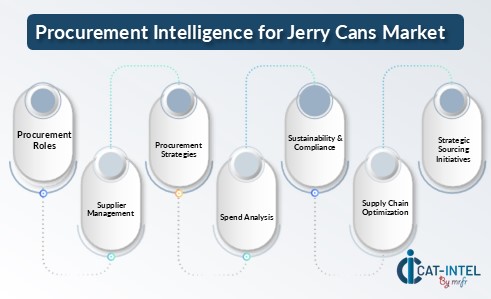
Procurement Intelligence for Jerry Cans Category Management and Strategic SourcingTo maintain a competitive edge in the jerry can industry, businesses are concentrating more on optimizing their procurement processes through expenditure monitoring and supplier performance tracking. Effective category management and strategic sourcing are critical for lowering procurement costs while ensuring a steady supply of high-quality raw materials and specialized components. Businesses can use data from the market to strengthen their procurement strategy, optimize material sourcing, and negotiate better terms with suppliers.
Pricing Outlook for Jerry Cans Spend Analysis
The pricing prognosis for the jerry can market is likely to remain moderately dynamic, with changes caused by a variety of causes. substance technology developments, demand for specialty jerry can designs (such as eco-friendly or hazardous substance containers), customization requirements, and geographical production cost variances are all significant factors.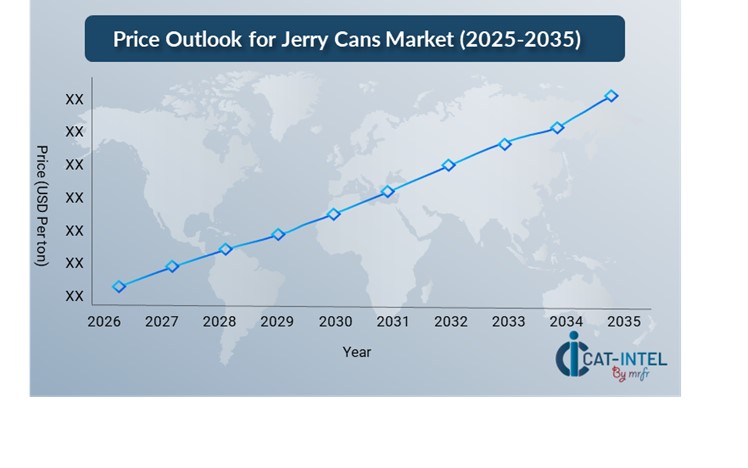
Graph shows general upward trend pricing for Jerry Cans and growing demand. However, there may be fluctuations influenced by economic conditions, technological advancements, and competitive dynamic.
Efforts to optimize procurement procedures, improve vendor management, and invest in modular solutions are critical to cost control in the jerry can business. Streamlining procurement with data-driven strategies and employing digital tools for market monitoring can improve pricing visibility and assist firms in forecasting cost changes.
While managing price rises can be difficult, focusing on scalability, ensuring efficient production methods, and implementing sustainable practices can help manufacturers remain cost-effective. Companies that can adapt to market demands, invest in novel material solutions, and optimize their procurement strategies will be well positioned to achieve operational excellence while controlling costs over time.
Cost Breakdown for Jerry Cans Total Cost of Ownership (TCO) and Cost-Saving Opportunities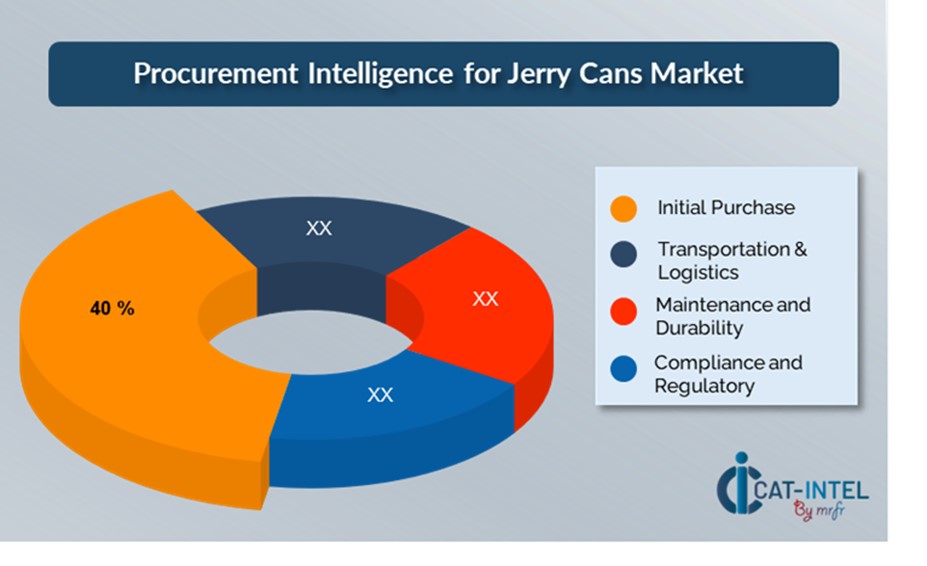
- Initial Purchase/Production (40%)
-
Description This is the initial cost of purchasing or manufacturing jerry cans, whether from a supplier or through in-house production. It covers the cost of raw materials, labour, machinery, and any tooling needed to manufacture the product.
-
Trend Increasing demand for recycled and environmentally friendly materials can either raise or lower costs, depending on availability and manufacturing procedures.
- Transportation & Logistics (XX%)
- Maintenance and Durability (XX%)
- Compliance and Regulatory (XX%)
Cost-Saving Opportunities Negotiation Levers and Purchasing Negotiation Strategies
In the jerry can sector, streamlining procurement processes and using effective negotiation strategies can lead to significant cost savings and increased operational efficiency. Companies that enter long-term partnerships with raw material suppliers and manufacturers, particularly those who offer sustainable or specialty materials, can benefit from superior pricing structures and attractive terms, such as volume-based discounts and bundled service packages. Subscription-Based and Long-Term Contracts Investigating subscription-based models or multi-year contracts with suppliers of specialist materials (e.g., eco-friendly plastics, metal containers) can help secure lower rates and reduce the impact of price variations over time.
Partnering with suppliers who value innovation and scalability provides extra advantages. Suppliers who invest in modern materials and environmentally friendly manufacturing techniques can reduce long-term operating expenses. Investing in modular designs that can be used in numerous industries, for example, can eliminate the need for constant retooling or redesigns, hence improving overall supply chain efficiency. By concentrating on innovation, scalability, and cost-effective procurement, small firms can not only control immediate costs but also ensure long-term competitiveness.
Supply and Demand Overview for Jerry Cans Demand-Supply Dynamics and Buyer Intelligence for Effective Supplier Relationship Management (SRM)
The jerry can market is steadily expanding, driven by rising demand in industries such as manufacturing, retail, logistics, and healthcare. Technological developments, industry-specific customization requirements, and global economic conditions all influence the supply and demand dynamics in the jerry can market.
Demand Factors
-
Sustainability and Environmental Standards The increased need for eco-friendly packaging and compliance with environmental standards is driving demand for sustainable jerry can solutions.
-
E-Commerce Growth and Logistics Needs As e-commerce and worldwide trade grow, there is a greater demand for long-lasting, leak-proof, and lightweight containers for packaging and shipping goods. -
Industry-Specific Requirements Industries like manufacturing and chemicals, and healthcare often require tailored jerry cans that comply with specific regulatory standards. -
Integration with Digital Systems Smart jerry cans with sensors can monitor temperature, pressure, and location, improving operational efficiency in transportation and storage.
Supply Factors
-
Technological advancements Jerry cans are performing better thanks to new materials that are more robust, lightweight, and environmentally friendly. 3D printing technology also enables more customizable designs, lowering lead times and prices.
-
Vendor Ecosystem As the number of jerries can manufacturers grows, from small, specialized suppliers to large-scale worldwide providers, competition increases and purchasers' options expand. -
Global Economic Factors Exchange rates, labour costs, and regional production capacities all have an impact on jerry can prices and availability. -
Scalability and Customization Modern jerry can systems are becoming more modular, allowing vendors to serve enterprises of all sizes and complexities.
Regional Demand-Supply Outlook Jerry Cans
The Image shows growing demand for Jerry Cans in both Asia Pacific and North America, with potential price increases and increased Competition.
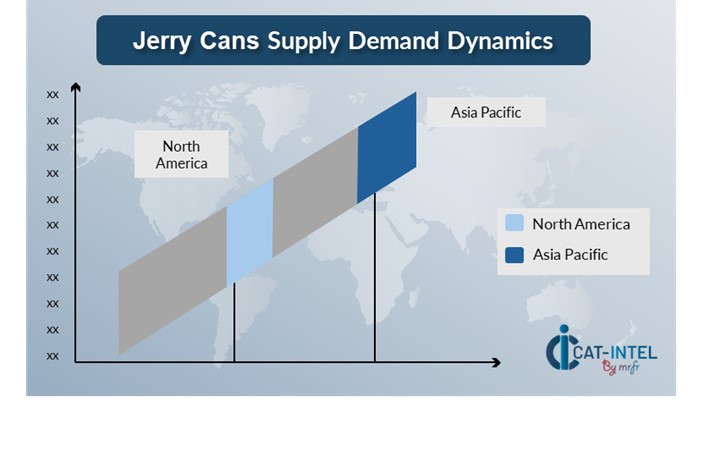
Asia Pacific Dominance in the Jerry Cans Market
Asia Pacific, particularly East Asia, is a dominant force in the global Jerry Cans market due to several key factors
-
Rapid Industrialization The rise of industries such as manufacturing, chemicals, food and beverage, and pharmaceuticals is increasing need for long-lasting packaging solutions like jerry cans for storage, transportation, and safe handling. -
Expanding the Logistics Sector The e-commerce growth in China, India, and Japan has considerably raised the demand for trustworthy and standardized packaging solutions, includes jerry cans for safe liquid and chemical transportation.
-
Cost-Effective Manufacturing Because of the low cost of labour and raw materials in countries such as China, India, and Vietnam, several worldwide jerries can manufacturers have established production facilities there.
-
Growing Demand for Sustainable Packaging To meet the needs of environmentally conscious companies and comply with stricter environmental regulations, several manufacturers are including recyclable and biodegradable materials into jerry can production.
-
Regulatory Support Governments in Asia-Pacific are increasingly focusing on regulatory frameworks that promote safe packaging of hazardous products, chemical handling, and transportation.

Asia Pacific Remains a key hub, Jerry Cans Price Drivers Innovation and Growth.
Supplier Landscape Supplier Negotiations and Strategies
The jerry can market is also impacted by a diversified and competitive supplier ecosystem, which includes both global and regional players who affect critical elements including price strategies, material customisation, and service quality. These suppliers play an important role in establishing the availability and cost of jerry cans, as well as ensuring that products satisfy industry standards. Established, large-scale manufacturers dominate the global jerry can market, providing a diverse range of standard products to numerous industries.
Smart technology integration into jerry can designs is becoming increasingly popular among market innovators. These features are especially beneficial in industries such as pharmaceuticals, chemicals, and food & beverage, where product safety and monitoring are essential. The jerry can market is defined by a complex and competitive supplier structure that balances multinational manufacturers' economies of scale against the flexibility and specialization of regional and local providers.
Key Suppliers in the Jerry Cans Market Include
- Parekhplast India Limited
- Mauser Group
- Greif Inc.
- SchÜTZ
- Sidel
- Berry Global Inc
- TimesCo Packaging
- Durrans Group
- Aerosol Packaging Industry
- Global PET Industries.
Key Developments Procurement Category Significant Development
Significant Development |
Description |
Market Growth |
The jerry can market is increasing rapidly because to rising demand in industries such as logistics, healthcare, manufacturing, and chemicals, where booming industrialization and e-commerce are pushing the need for dependable packaging solutions. |
Cloud Adoption |
As industry and governments prioritize environmental responsibility, there is a growing need for eco-friendly jerry cans comprised of recyclable or biodegradable materials. |
Product Innovation |
Manufacturers are developing smart packaging solutions, such as IoT-enabled jerry cans that monitor temperature, pressure, and location, for industries where product integrity and safety are critical, such as pharmaceuticals, chemicals, and food storage. |
Technological Advancements |
The use of 3D printing, modern materials, and automation in jerry can production improves manufacturing efficiency, enables large-scale customization, and allows producers to offer specific solutions to consumers. |
Global Trade Dynamics |
Changes in trade legislation, customs policies, and economic conditions are all having an impact on the jerry can market, particularly for multinational corporations managing complicated supply chains. Compliance with local regulations is encouraging the development of specialized containers in various countries. |
Customization Trends |
There is an increasing demand for customized jerry cans that are tailored to specific industrial requirements, such as hazardous material handling, food-grade containers, and modular designs for ease of transportation. |
|
Jerry Cans Attribute/Metric |
Details |
Market Sizing |
The global Jerry Cans market is projected to reach USD 5.19 billion by 2035, growing at a CAGR of approximately 4.71% from 2025 to 2035. |
Jerry Cans Technology Adoption Rate |
70% of enterprises in critical industries such as pharmaceuticals, food processing, and chemicals use customized jerrycans for storage and transportation, indicating a growing demand for eco-friendly and smart packaging options. |
Top Jerry Cans Industry Strategies for 2025 |
Investing in sustainable materials, such as biodegradable plastics, implementing smart packaging solutions for IoT-enabled tracking, and improving adaptation for industry-specific requirements, such as hazardous material handling, are all important strategies.
|
Jerry Cans Process Automation |
Approximately 60% of manufacturers now provide customized jerry can solutions to fulfil specific industry requirements, such as food-grade containers, chemical-resistant materials, and modular designs for improved logistics.
|
Jerry Cans Process Challenges |
Major issues include material cost volatility, fulfilling rigorous environmental regulations, worldwide supply chain interruptions, and assuring jerry can durability and reusability in a variety of industrial applications.
|
Key Suppliers |
Leading jerry can manufacturers include Parekhplast India Limited, Mauser Group, Greif and Sidel, who provide a wide range of conventional and bespoke containers for various industries.
|
Key Regions Covered |
Asia Pacific, North America and Europe are key locations for jerry can adoption, with significant demand in industries such as chemicals, pharmaceuticals, and food and beverage, as well as a growing emphasis on emerging markets like as India and Africa.
|
Market Drivers and Trends |
Growth is being driven by rising demand for eco-friendly packaging, the rise of digitization in supply chains (including IoT integration), and a greater emphasis on safety compliance in many industries.
|








